traction control FORD EDGE 2020 Owner's Manual
[x] Cancel search | Manufacturer: FORD, Model Year: 2020, Model line: EDGE, Model: FORD EDGE 2020Pages: 495, PDF Size: 6.38 MB
Page 255 of 495
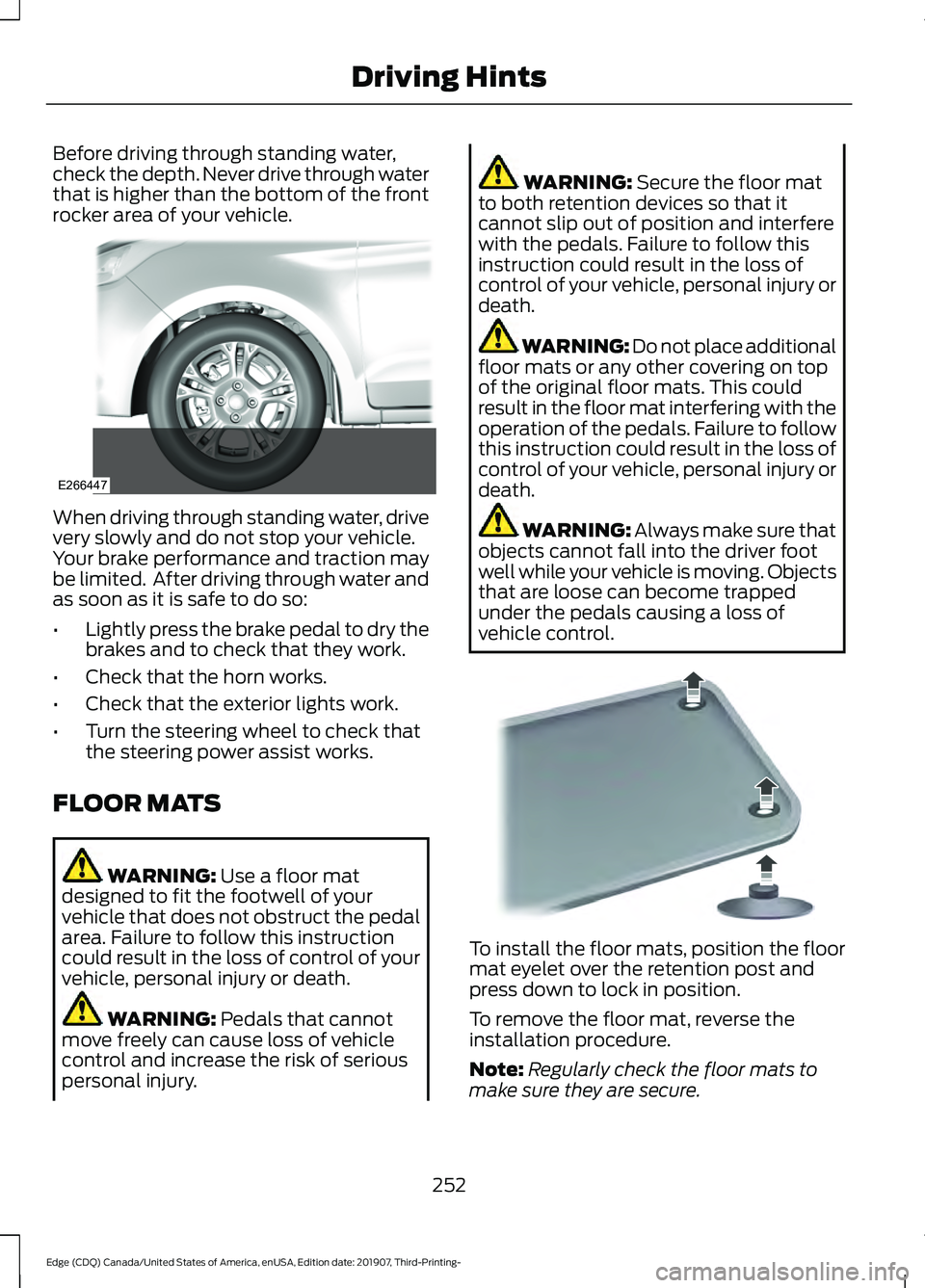
Before driving through standing water,
check the depth. Never drive through water
that is higher than the bottom of the front
rocker area of your vehicle.
When driving through standing water, drive
very slowly and do not stop your vehicle.
Your brake performance and traction may
be limited. After driving through water and
as soon as it is safe to do so:
•
Lightly press the brake pedal to dry the
brakes and to check that they work.
• Check that the horn works.
• Check that the exterior lights work.
• Turn the steering wheel to check that
the steering power assist works.
FLOOR MATS WARNING: Use a floor mat
designed to fit the footwell of your
vehicle that does not obstruct the pedal
area. Failure to follow this instruction
could result in the loss of control of your
vehicle, personal injury or death. WARNING:
Pedals that cannot
move freely can cause loss of vehicle
control and increase the risk of serious
personal injury. WARNING:
Secure the floor mat
to both retention devices so that it
cannot slip out of position and interfere
with the pedals. Failure to follow this
instruction could result in the loss of
control of your vehicle, personal injury or
death. WARNING: Do not place additional
floor mats or any other covering on top
of the original floor mats. This could
result in the floor mat interfering with the
operation of the pedals. Failure to follow
this instruction could result in the loss of
control of your vehicle, personal injury or
death. WARNING:
Always make sure that
objects cannot fall into the driver foot
well while your vehicle is moving. Objects
that are loose can become trapped
under the pedals causing a loss of
vehicle control. To install the floor mats, position the floor
mat eyelet over the retention post and
press down to lock in position.
To remove the floor mat, reverse the
installation procedure.
Note:
Regularly check the floor mats to
make sure they are secure.
252
Edge (CDQ) Canada/United States of America, enUSA, Edition date: 201907, Third-Printing- Driving HintsE266447 E142666
Page 308 of 495
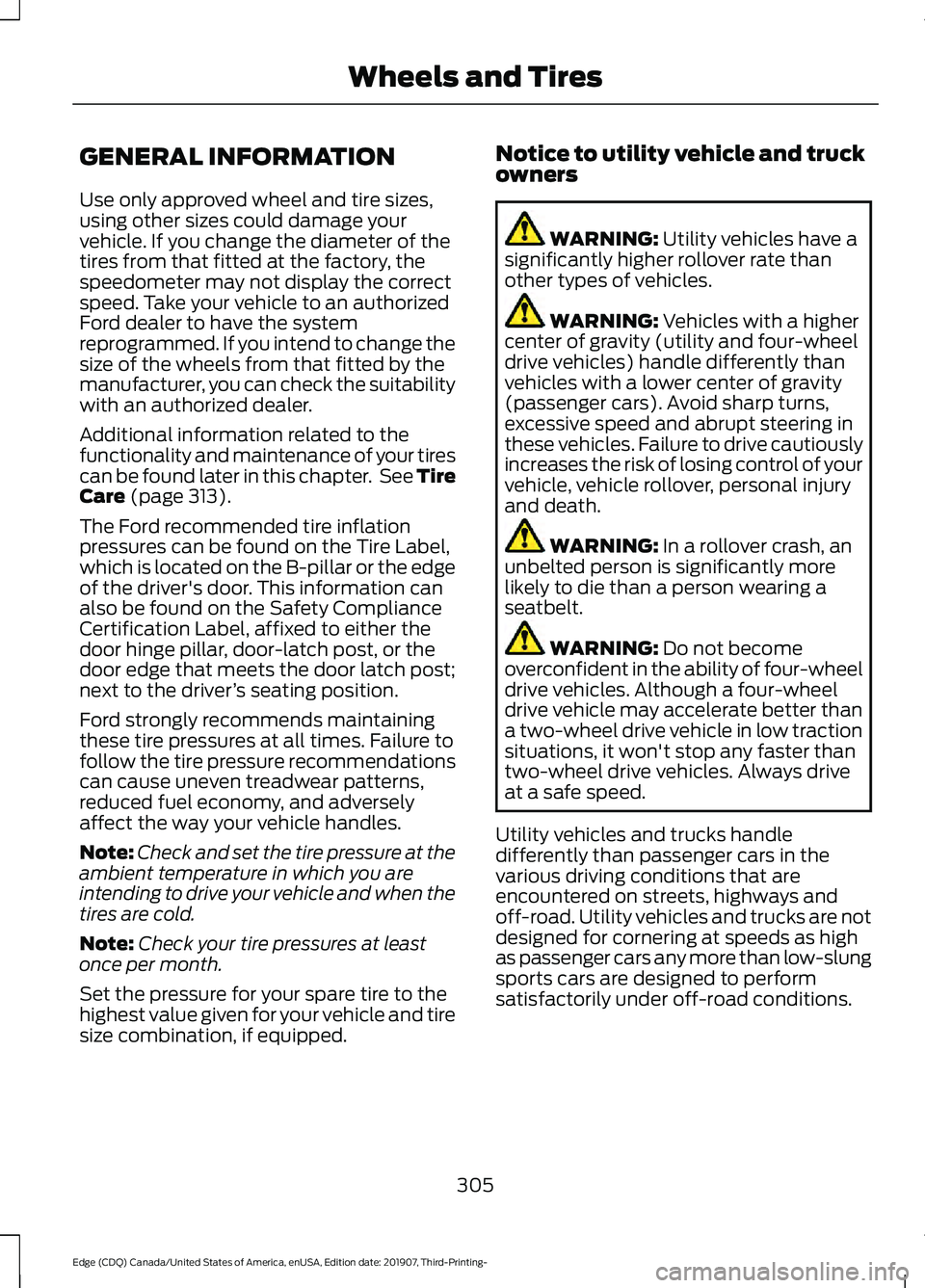
GENERAL INFORMATION
Use only approved wheel and tire sizes,
using other sizes could damage your
vehicle. If you change the diameter of the
tires from that fitted at the factory, the
speedometer may not display the correct
speed. Take your vehicle to an authorized
Ford dealer to have the system
reprogrammed. If you intend to change the
size of the wheels from that fitted by the
manufacturer, you can check the suitability
with an authorized dealer.
Additional information related to the
functionality and maintenance of your tires
can be found later in this chapter. See Tire
Care (page 313).
The Ford recommended tire inflation
pressures can be found on the Tire Label,
which is located on the B-pillar or the edge
of the driver's door. This information can
also be found on the Safety Compliance
Certification Label, affixed to either the
door hinge pillar, door-latch post, or the
door edge that meets the door latch post;
next to the driver ’s seating position.
Ford strongly recommends maintaining
these tire pressures at all times. Failure to
follow the tire pressure recommendations
can cause uneven treadwear patterns,
reduced fuel economy, and adversely
affect the way your vehicle handles.
Note: Check and set the tire pressure at the
ambient temperature in which you are
intending to drive your vehicle and when the
tires are cold.
Note: Check your tire pressures at least
once per month.
Set the pressure for your spare tire to the
highest value given for your vehicle and tire
size combination, if equipped. Notice to utility vehicle and truck
owners WARNING:
Utility vehicles have a
significantly higher rollover rate than
other types of vehicles. WARNING:
Vehicles with a higher
center of gravity (utility and four-wheel
drive vehicles) handle differently than
vehicles with a lower center of gravity
(passenger cars). Avoid sharp turns,
excessive speed and abrupt steering in
these vehicles. Failure to drive cautiously
increases the risk of losing control of your
vehicle, vehicle rollover, personal injury
and death. WARNING:
In a rollover crash, an
unbelted person is significantly more
likely to die than a person wearing a
seatbelt. WARNING:
Do not become
overconfident in the ability of four-wheel
drive vehicles. Although a four-wheel
drive vehicle may accelerate better than
a two-wheel drive vehicle in low traction
situations, it won't stop any faster than
two-wheel drive vehicles. Always drive
at a safe speed.
Utility vehicles and trucks handle
differently than passenger cars in the
various driving conditions that are
encountered on streets, highways and
off-road. Utility vehicles and trucks are not
designed for cornering at speeds as high
as passenger cars any more than low-slung
sports cars are designed to perform
satisfactorily under off-road conditions.
305
Edge (CDQ) Canada/United States of America, enUSA, Edition date: 201907, Third-Printing- Wheels and Tires
Page 318 of 495
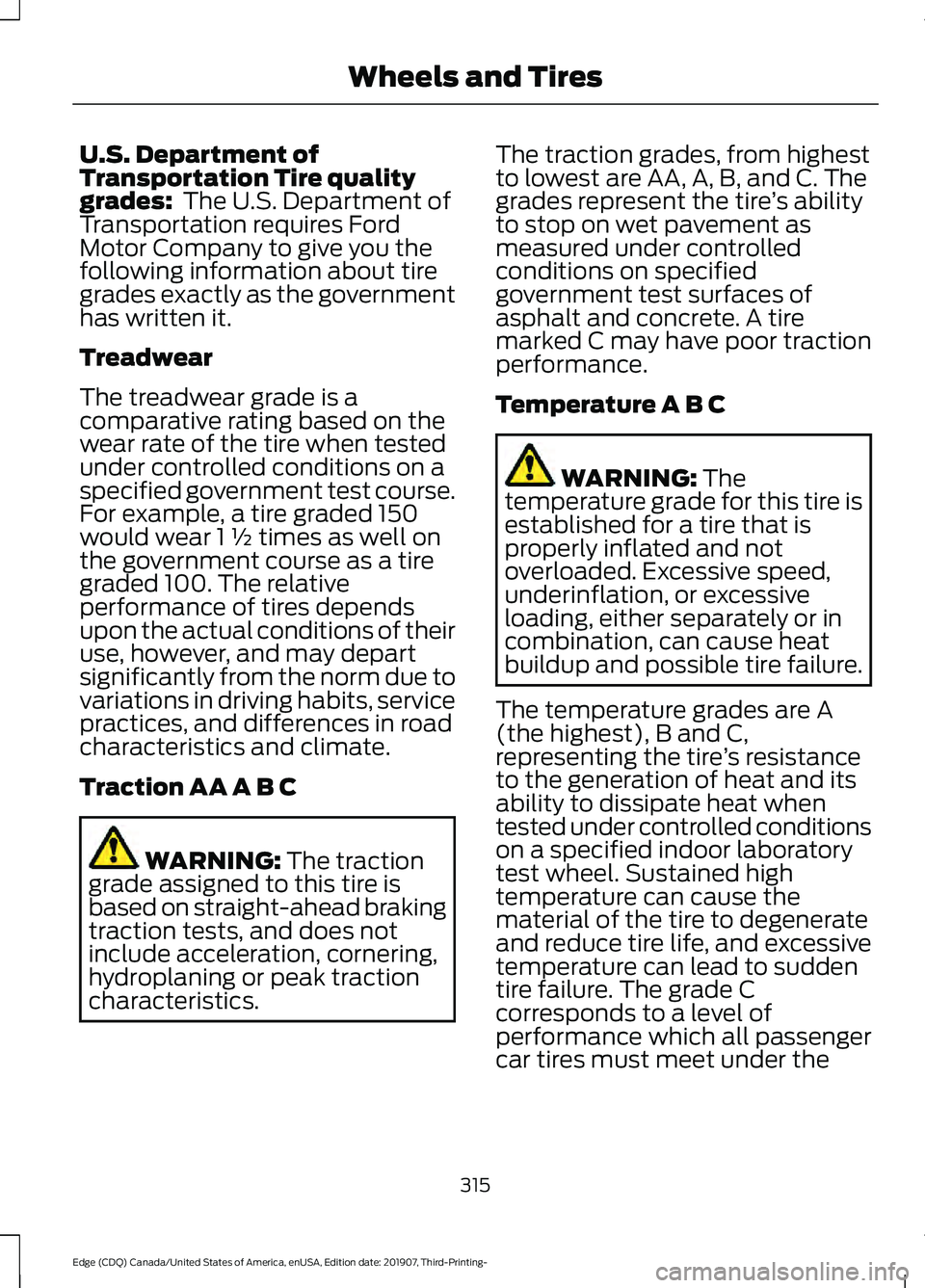
U.S. Department of
Transportation Tire quality
grades: The U.S. Department of
Transportation requires Ford
Motor Company to give you the
following information about tire
grades exactly as the government
has written it.
Treadwear
The treadwear grade is a
comparative rating based on the
wear rate of the tire when tested
under controlled conditions on a
specified government test course.
For example, a tire graded 150
would wear 1 ½ times as well on
the government course as a tire
graded 100. The relative
performance of tires depends
upon the actual conditions of their
use, however, and may depart
significantly from the norm due to
variations in driving habits, service
practices, and differences in road
characteristics and climate.
Traction AA A B C WARNING:
The traction
grade assigned to this tire is
based on straight-ahead braking
traction tests, and does not
include acceleration, cornering,
hydroplaning or peak traction
characteristics. The traction grades, from highest
to lowest are AA, A, B, and C. The
grades represent the tire
’s ability
to stop on wet pavement as
measured under controlled
conditions on specified
government test surfaces of
asphalt and concrete. A tire
marked C may have poor traction
performance.
Temperature A B C WARNING:
The
temperature grade for this tire is
established for a tire that is
properly inflated and not
overloaded. Excessive speed,
underinflation, or excessive
loading, either separately or in
combination, can cause heat
buildup and possible tire failure.
The temperature grades are A
(the highest), B and C,
representing the tire ’s resistance
to the generation of heat and its
ability to dissipate heat when
tested under controlled conditions
on a specified indoor laboratory
test wheel. Sustained high
temperature can cause the
material of the tire to degenerate
and reduce tire life, and excessive
temperature can lead to sudden
tire failure. The grade C
corresponds to a level of
performance which all passenger
car tires must meet under the
315
Edge (CDQ) Canada/United States of America, enUSA, Edition date: 201907, Third-Printing- Wheels and Tires
Page 322 of 495
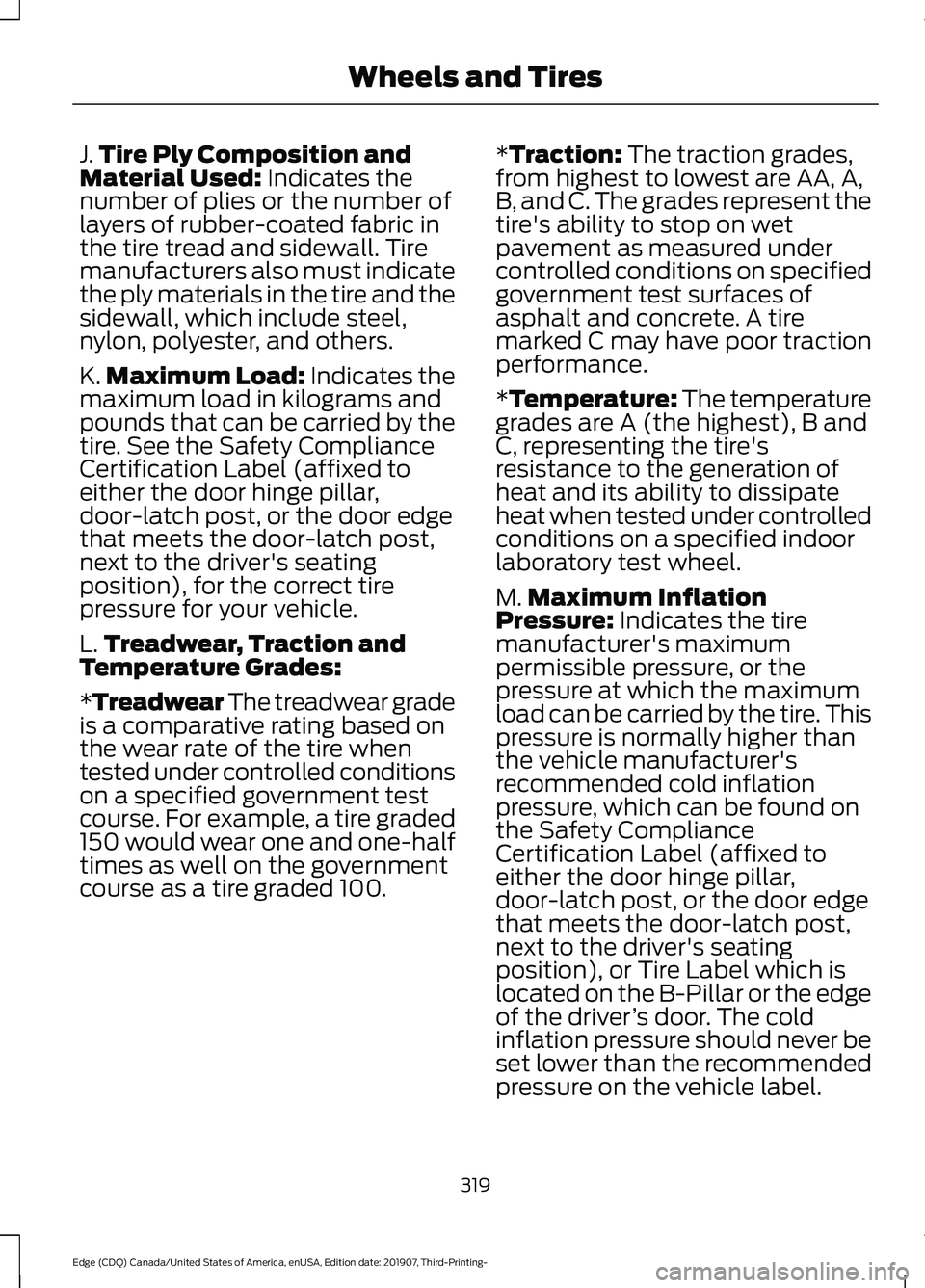
J.
Tire Ply Composition and
Material Used: Indicates the
number of plies or the number of
layers of rubber-coated fabric in
the tire tread and sidewall. Tire
manufacturers also must indicate
the ply materials in the tire and the
sidewall, which include steel,
nylon, polyester, and others.
K. Maximum Load: Indicates the
maximum load in kilograms and
pounds that can be carried by the
tire. See the Safety Compliance
Certification Label (affixed to
either the door hinge pillar,
door-latch post, or the door edge
that meets the door-latch post,
next to the driver's seating
position), for the correct tire
pressure for your vehicle.
L. Treadwear, Traction and
Temperature Grades:
*Treadwear The treadwear grade
is a comparative rating based on
the wear rate of the tire when
tested under controlled conditions
on a specified government test
course. For example, a tire graded
150 would wear one and one-half
times as well on the government
course as a tire graded 100. *Traction: The traction grades,
from highest to lowest are AA, A,
B, and C. The grades represent the
tire's ability to stop on wet
pavement as measured under
controlled conditions on specified
government test surfaces of
asphalt and concrete. A tire
marked C may have poor traction
performance.
*
Temperature: The temperature
grades are A (the highest), B and
C, representing the tire's
resistance to the generation of
heat and its ability to dissipate
heat when tested under controlled
conditions on a specified indoor
laboratory test wheel.
M. Maximum Inflation
Pressure:
Indicates the tire
manufacturer's maximum
permissible pressure, or the
pressure at which the maximum
load can be carried by the tire. This
pressure is normally higher than
the vehicle manufacturer's
recommended cold inflation
pressure, which can be found on
the Safety Compliance
Certification Label (affixed to
either the door hinge pillar,
door-latch post, or the door edge
that meets the door-latch post,
next to the driver's seating
position), or Tire Label which is
located on the B-Pillar or the edge
of the driver ’s door. The cold
inflation pressure should never be
set lower than the recommended
pressure on the vehicle label.
319
Edge (CDQ) Canada/United States of America, enUSA, Edition date: 201907, Third-Printing- Wheels and Tires
Page 332 of 495
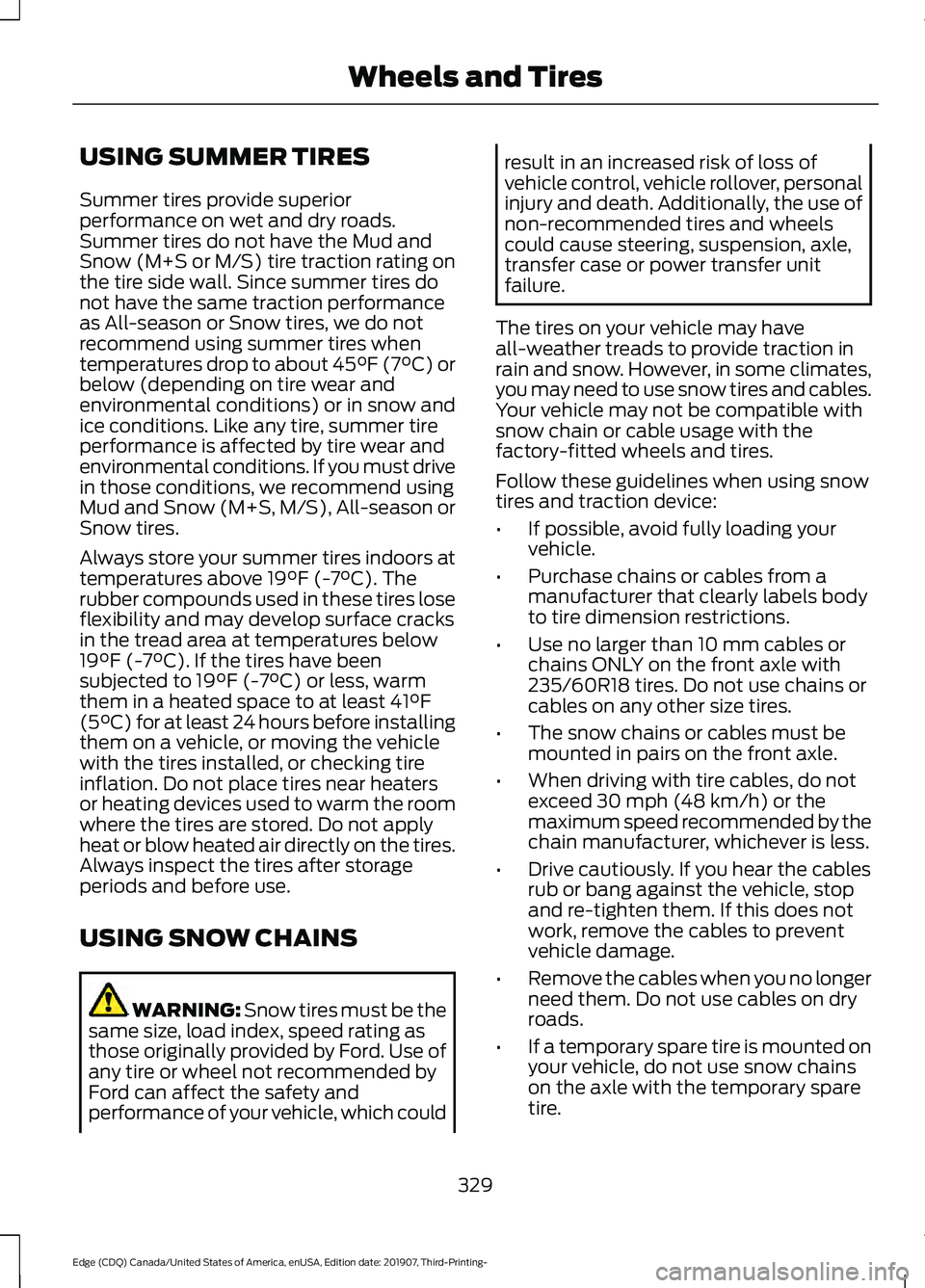
USING SUMMER TIRES
Summer tires provide superior
performance on wet and dry roads.
Summer tires do not have the Mud and
Snow (M+S or M/S) tire traction rating on
the tire side wall. Since summer tires do
not have the same traction performance
as All-season or Snow tires, we do not
recommend using summer tires when
temperatures drop to about 45°F (7°C) or
below (depending on tire wear and
environmental conditions) or in snow and
ice conditions. Like any tire, summer tire
performance is affected by tire wear and
environmental conditions. If you must drive
in those conditions, we recommend using
Mud and Snow (M+S, M/S), All-season or
Snow tires.
Always store your summer tires indoors at
temperatures above 19°F (-7°C). The
rubber compounds used in these tires lose
flexibility and may develop surface cracks
in the tread area at temperatures below
19°F (-7°C)
. If the tires have been
subjected to 19°F (-7°C) or less, warm
them in a heated space to at least 41°F
(5°C) for at least 24 hours before installing
them on a vehicle, or moving the vehicle
with the tires installed, or checking tire
inflation. Do not place tires near heaters
or heating devices used to warm the room
where the tires are stored. Do not apply
heat or blow heated air directly on the tires.
Always inspect the tires after storage
periods and before use.
USING SNOW CHAINS WARNING:
Snow tires must be the
same size, load index, speed rating as
those originally provided by Ford. Use of
any tire or wheel not recommended by
Ford can affect the safety and
performance of your vehicle, which could result in an increased risk of loss of
vehicle control, vehicle rollover, personal
injury and death. Additionally, the use of
non-recommended tires and wheels
could cause steering, suspension, axle,
transfer case or power transfer unit
failure.
The tires on your vehicle may have
all-weather treads to provide traction in
rain and snow. However, in some climates,
you may need to use snow tires and cables.
Your vehicle may not be compatible with
snow chain or cable usage with the
factory-fitted wheels and tires.
Follow these guidelines when using snow
tires and traction device:
• If possible, avoid fully loading your
vehicle.
• Purchase chains or cables from a
manufacturer that clearly labels body
to tire dimension restrictions.
• Use no larger than 10 mm cables or
chains ONLY on the front axle with
235/60R18 tires. Do not use chains or
cables on any other size tires.
• The snow chains or cables must be
mounted in pairs on the front axle.
• When driving with tire cables, do not
exceed
30 mph (48 km/h) or the
maximum speed recommended by the
chain manufacturer, whichever is less.
• Drive cautiously. If you hear the cables
rub or bang against the vehicle, stop
and re-tighten them. If this does not
work, remove the cables to prevent
vehicle damage.
• Remove the cables when you no longer
need them. Do not use cables on dry
roads.
• If a temporary spare tire is mounted on
your vehicle, do not use snow chains
on the axle with the temporary spare
tire.
329
Edge (CDQ) Canada/United States of America, enUSA, Edition date: 201907, Third-Printing- Wheels and Tires
Page 456 of 495
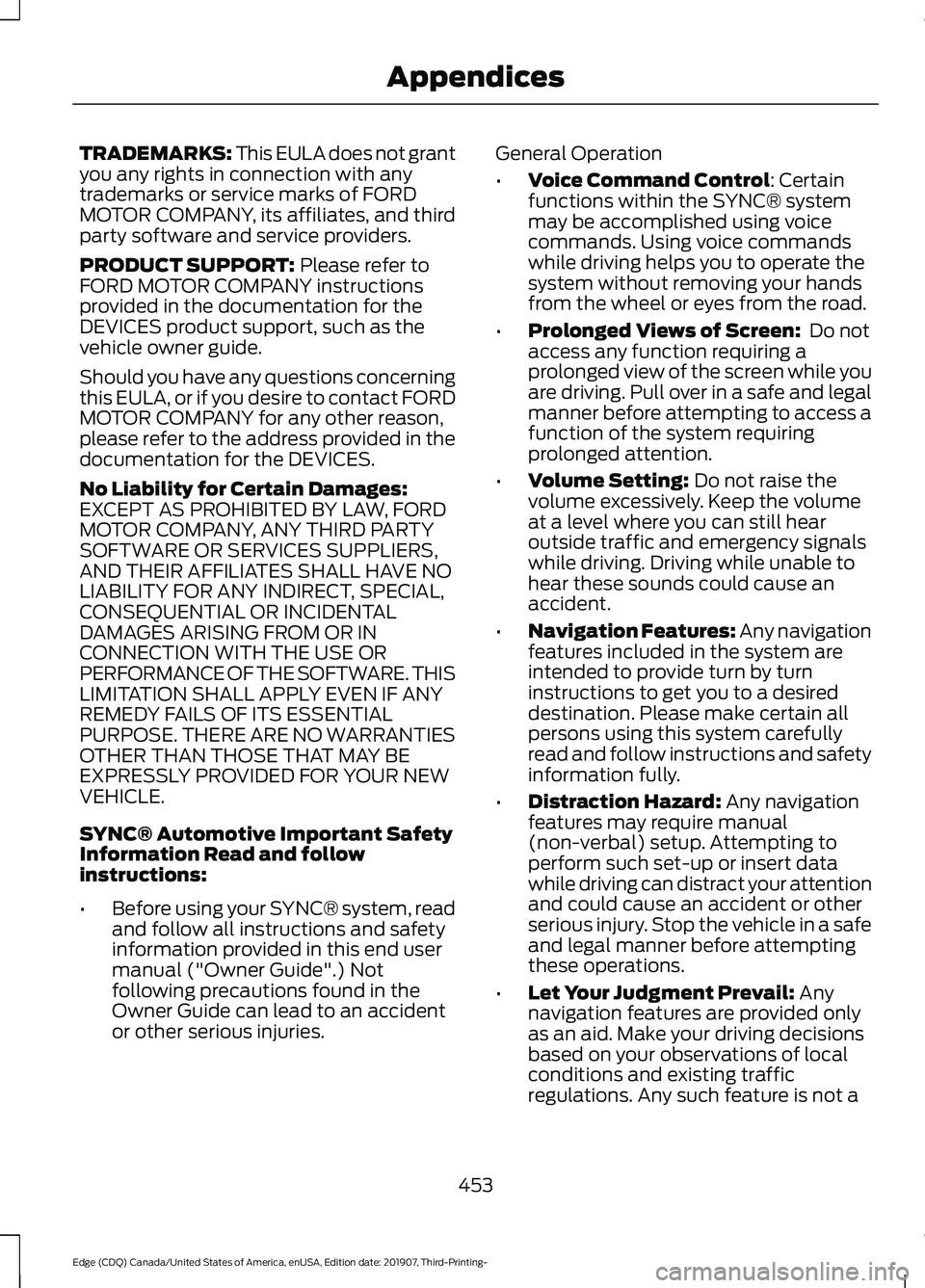
TRADEMARKS: This EULA does not grant
you any rights in connection with any
trademarks or service marks of FORD
MOTOR COMPANY, its affiliates, and third
party software and service providers.
PRODUCT SUPPORT: Please refer to
FORD MOTOR COMPANY instructions
provided in the documentation for the
DEVICES product support, such as the
vehicle owner guide.
Should you have any questions concerning
this EULA, or if you desire to contact FORD
MOTOR COMPANY for any other reason,
please refer to the address provided in the
documentation for the DEVICES.
No Liability for Certain Damages:
EXCEPT AS PROHIBITED BY LAW, FORD
MOTOR COMPANY, ANY THIRD PARTY
SOFTWARE OR SERVICES SUPPLIERS,
AND THEIR AFFILIATES SHALL HAVE NO
LIABILITY FOR ANY INDIRECT, SPECIAL,
CONSEQUENTIAL OR INCIDENTAL
DAMAGES ARISING FROM OR IN
CONNECTION WITH THE USE OR
PERFORMANCE OF THE SOFTWARE. THIS
LIMITATION SHALL APPLY EVEN IF ANY
REMEDY FAILS OF ITS ESSENTIAL
PURPOSE. THERE ARE NO WARRANTIES
OTHER THAN THOSE THAT MAY BE
EXPRESSLY PROVIDED FOR YOUR NEW
VEHICLE.
SYNC® Automotive Important Safety
Information Read and follow
instructions:
• Before using your SYNC® system, read
and follow all instructions and safety
information provided in this end user
manual ("Owner Guide".) Not
following precautions found in the
Owner Guide can lead to an accident
or other serious injuries. General Operation
•
Voice Command Control
: Certain
functions within the SYNC® system
may be accomplished using voice
commands. Using voice commands
while driving helps you to operate the
system without removing your hands
from the wheel or eyes from the road.
• Prolonged Views of Screen:
Do not
access any function requiring a
prolonged view of the screen while you
are driving. Pull over in a safe and legal
manner before attempting to access a
function of the system requiring
prolonged attention.
• Volume Setting:
Do not raise the
volume excessively. Keep the volume
at a level where you can still hear
outside traffic and emergency signals
while driving. Driving while unable to
hear these sounds could cause an
accident.
• Navigation Features:
Any navigation
features included in the system are
intended to provide turn by turn
instructions to get you to a desired
destination. Please make certain all
persons using this system carefully
read and follow instructions and safety
information fully.
• Distraction Hazard:
Any navigation
features may require manual
(non-verbal) setup. Attempting to
perform such set-up or insert data
while driving can distract your attention
and could cause an accident or other
serious injury. Stop the vehicle in a safe
and legal manner before attempting
these operations.
• Let Your Judgment Prevail:
Any
navigation features are provided only
as an aid. Make your driving decisions
based on your observations of local
conditions and existing traffic
regulations. Any such feature is not a
453
Edge (CDQ) Canada/United States of America, enUSA, Edition date: 201907, Third-Printing- Appendices
Page 489 of 495
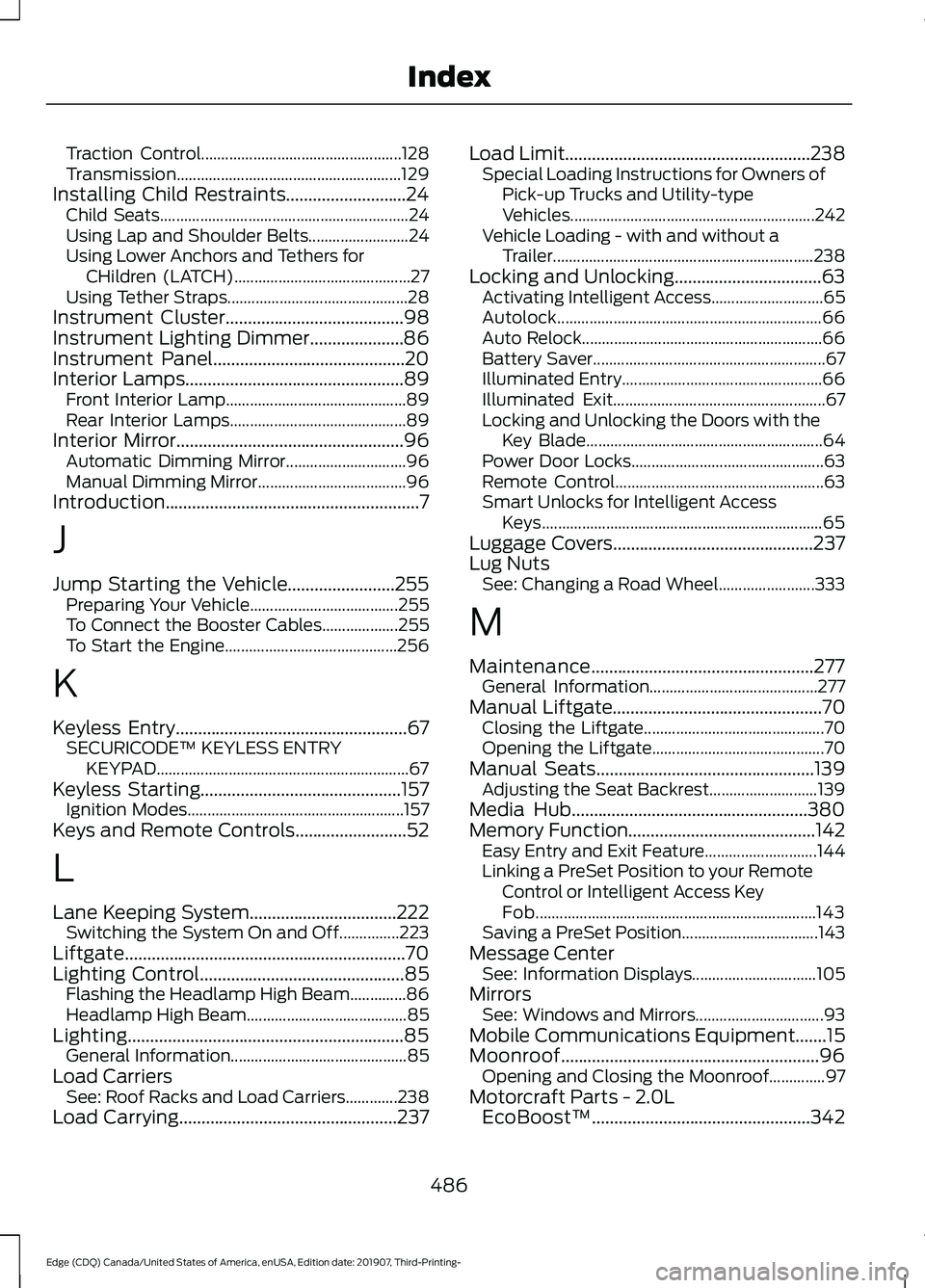
Traction Control..................................................
128
Transmission........................................................ 129
Installing Child Restraints...........................24
Child Seats.............................................................. 24
Using Lap and Shoulder Belts......................... 24
Using Lower Anchors and Tethers for CHildren (LATCH)............................................ 27
Using Tether Straps............................................. 28
Instrument Cluster
........................................98
Instrument Lighting Dimmer.....................86
Instrument Panel
...........................................20
Interior Lamps.................................................89
Front Interior Lamp............................................. 89
Rear Interior Lamps............................................ 89
Interior Mirror
...................................................96
Automatic Dimming Mirror.............................. 96
Manual Dimming Mirror..................................... 96
Introduction.........................................................7
J
Jump Starting the Vehicle........................255 Preparing Your Vehicle..................................... 255
To Connect the Booster Cables................... 255
To Start the Engine........................................... 256
K
Keyless Entry
....................................................67
SECURICODE™ KEYLESS ENTRY
KEYPAD............................................................... 67
Keyless Starting
.............................................157
Ignition Modes...................................................... 157
Keys and Remote Controls.........................52
L
Lane Keeping System.................................222 Switching the System On and Off...............223
Liftgate...............................................................70
Lighting Control
..............................................85
Flashing the Headlamp High Beam..............86
Headlamp High Beam........................................ 85
Lighting..............................................................85 General Information............................................ 85
Load Carriers See: Roof Racks and Load Carriers.............238
Load Carrying
.................................................237 Load Limit.......................................................238
Special Loading Instructions for Owners of
Pick-up Trucks and Utility-type
Vehicles............................................................. 242
Vehicle Loading - with and without a Trailer................................................................. 238
Locking and Unlocking.................................63 Activating Intelligent Access............................ 65
Autolock.................................................................. 66
Auto Relock............................................................ 66
Battery Saver.......................................................... 67
Illuminated Entry.................................................. 66
Illuminated Exit..................................................... 67
Locking and Unlocking the Doors with the Key Blade........................................................... 64
Power Door Locks................................................ 63
Remote Control.................................................... 63
Smart Unlocks for Intelligent Access Keys...................................................................... 65
Luggage Covers.............................................237
Lug Nuts See: Changing a Road Wheel........................ 333
M
Maintenance..................................................277 General Information.......................................... 277
Manual Liftgate
...............................................70
Closing the Liftgate............................................. 70
Opening the Liftgate........................................... 70
Manual Seats.................................................139 Adjusting the Seat Backrest........................... 139
Media Hub.....................................................380
Memory Function
..........................................142
Easy Entry and Exit Feature............................ 144
Linking a PreSet Position to your Remote Control or Intelligent Access Key
Fob...................................................................... 143
Saving a PreSet Position.................................. 143
Message Center See: Information Displays............................... 105
Mirrors See: Windows and Mirrors................................ 93
Mobile Communications Equipment.......15
Moonroof
..........................................................96
Opening and Closing the Moonroof..............97
Motorcraft Parts - 2.0L EcoBoost™.................................................342
486
Edge (CDQ) Canada/United States of America, enUSA, Edition date: 201907, Third-Printing- Index
Page 493 of 495
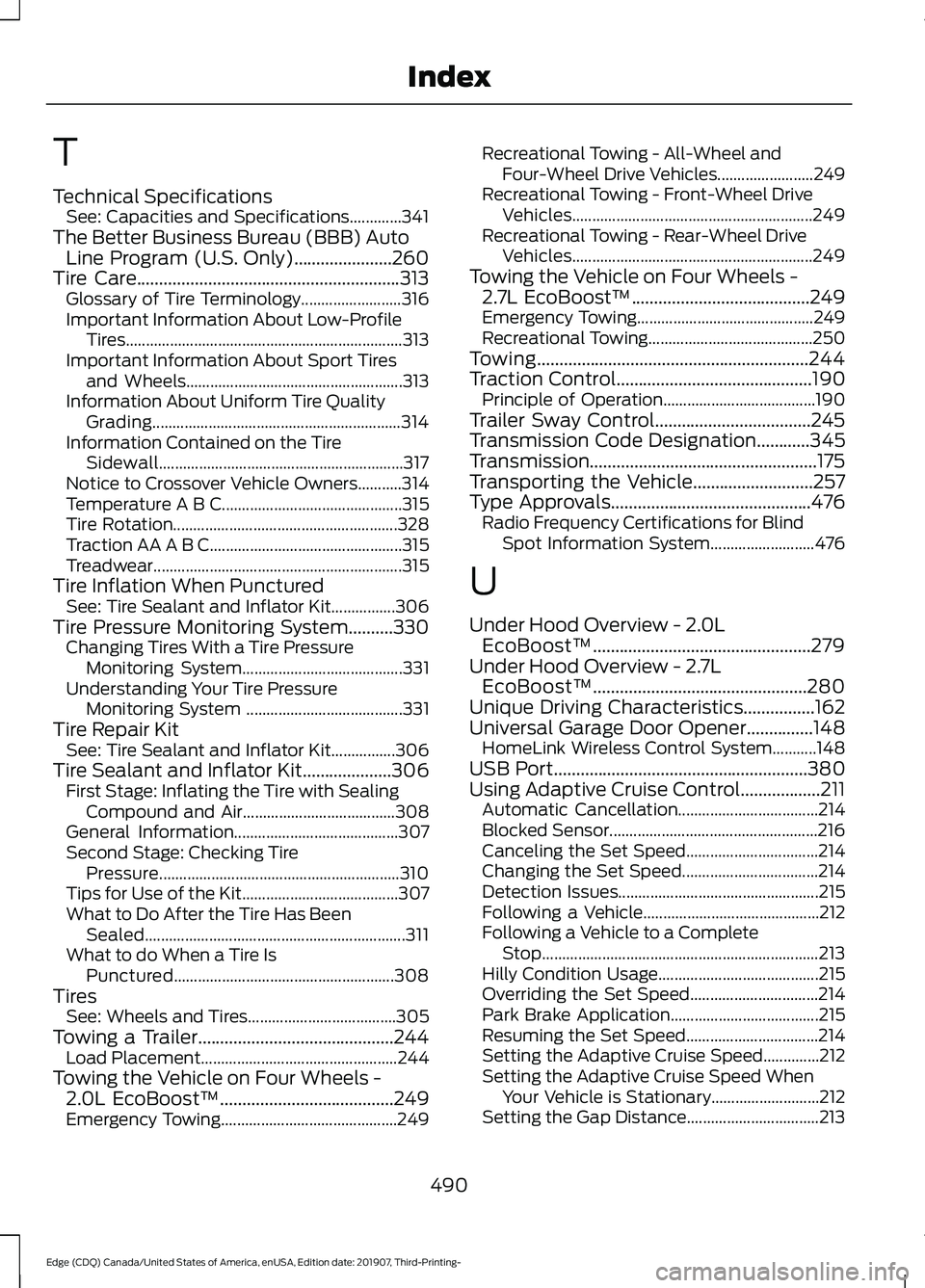
T
Technical Specifications
See: Capacities and Specifications.............341
The Better Business Bureau (BBB) Auto Line Program (U.S. Only)......................260
Tire Care...........................................................313
Glossary of Tire Terminology......................... 316
Important Information About Low-Profile Tires..................................................................... 313
Important Information About Sport Tires and Wheels...................................................... 313
Information About Uniform Tire Quality Grading.............................................................. 314
Information Contained on the Tire Sidewall............................................................. 317
Notice to Crossover Vehicle Owners...........314
Temperature A B C............................................. 315
Tire Rotation........................................................ 328
Traction AA A B C................................................ 315
Treadwear.............................................................. 315
Tire Inflation When Punctured See: Tire Sealant and Inflator Kit................306
Tire Pressure Monitoring System..........330 Changing Tires With a Tire Pressure
Monitoring System........................................ 331
Understanding Your Tire Pressure Monitoring System ....................................... 331
Tire Repair Kit See: Tire Sealant and Inflator Kit................306
Tire Sealant and Inflator Kit....................306 First Stage: Inflating the Tire with Sealing
Compound and Air...................................... 308
General Information......................................... 307
Second Stage: Checking Tire Pressure............................................................ 310
Tips for Use of the Kit....................................... 307
What to Do After the Tire Has Been Sealed................................................................. 311
What to do When a Tire Is Punctured....................................................... 308
Tires See: Wheels and Tires..................................... 305
Towing a Trailer............................................244 Load Placement................................................. 244
Towing the Vehicle on Four Wheels - 2.0L EcoBoost™.......................................249
Emergency Towing............................................ 249Recreational Towing - All-Wheel and
Four-Wheel Drive Vehicles........................ 249
Recreational Towing - Front-Wheel Drive Vehicles............................................................ 249
Recreational Towing - Rear-Wheel Drive Vehicles............................................................ 249
Towing the Vehicle on Four Wheels - 2.7L EcoBoost™........................................249
Emergency Towing............................................ 249
Recreational Towing......................................... 250
Towing.............................................................244
Traction Control
............................................190
Principle of Operation...................................... 190
Trailer Sway Control...................................245
Transmission Code Designation............345
Transmission...................................................175
Transporting the Vehicle
...........................257
Type Approvals.............................................476
Radio Frequency Certifications for Blind
Spot Information System.......................... 476
U
Under Hood Overview - 2.0L EcoBoost™.................................................279
Under Hood Overview - 2.7L EcoBoost™................................................280
Unique Driving Characteristics................162
Universal Garage Door Opener...............148 HomeLink Wireless Control System...........148
USB Port
.........................................................380
Using Adaptive Cruise Control..................211
Automatic Cancellation................................... 214
Blocked Sensor.................................................... 216
Canceling the Set Speed................................. 214
Changing the Set Speed.................................. 214
Detection Issues.................................................. 215
Following a Vehicle............................................ 212
Following a Vehicle to a Complete Stop..................................................................... 213
Hilly Condition Usage........................................ 215
Overriding the Set Speed................................ 214
Park Brake Application..................................... 215
Resuming the Set Speed................................. 214
Setting the Adaptive Cruise Speed..............212
Setting the Adaptive Cruise Speed When Your Vehicle is Stationary........................... 212
Setting the Gap Distance................................. 213
490
Edge (CDQ) Canada/United States of America, enUSA, Edition date: 201907, Third-Printing- Index
Page 494 of 495

Switching Adaptive Cruise Control
Off........................................................................\
215
Switching Adaptive Cruise Control On........................................................................\
. 212
Switching to Normal Cruise Control............218
System Not Available........................................ 216
Using Lane Centering........................................ 218
Using All-Wheel Drive..................................181 Driving in Special Conditions with All-Wheel
Drive (AWD)...................................................... 181
Using MyKey With Remote Start Systems...........................................................61
Using Snow Chains.....................................329
Using Stability Control................................192
Electronic Stability Control ............................ 192
Using Summer Tires...................................329
Using Traction Control
...............................190
Switching the System Off............................... 190
System Indicator Lights and Messages......................................................... 190
Using a Switch..................................................... 190
Using Voice Recognition...........................383 Apps....................................................................... 388
Automatic Blower Motor Speed Reduction........................................................ 389
Climate.................................................................. 385
Entertainment.................................................... 384
General.................................................................. 383
Navigation............................................................. 387
Phone.................................................................... 386
SiriusXM Traffic and Travel Link.................. 388
Voice Settings..................................................... 389
Utilizing the Mediation/Arbitration Program (Canada Only)
.........................261
V
Vehicle Care
...................................................297
General Information.......................................... 297
Vehicle Certification Label.......................345
Vehicle Identification Number................344
Vehicle Storage
............................................302
Body....................................................................... 303
Brakes.................................................................... 303
Cooling system................................................... 303
Disconnecting Your 12 Volt Battery.............303
Engine.................................................................... 303
Fuel system......................................................... 303General..................................................................
303
Miscellaneous..................................................... 304
Removing Vehicle From Storage.................304
Tires........................................................................\
303
Vehicle Wi-Fi Hotspot.................................371
Ventilation See: Climate Control.......................................... 131
VIN See: Vehicle Identification Number............344
Voice Control...................................................80
W
Warning Lamps and Indicators................101 Adaptive Cruise Control.................................... 101
Anti-Lock Braking System............................... 101
Automatic Headlamp High Beam Indicator............................................................. 101
Auto Start-stop.................................................... 101
Battery..................................................................... 101
Blind Spot Monitor.............................................. 101
Brake System........................................................ 101
Cruise Control...................................................... 102
Direction Indicator.............................................. 102
Door Ajar................................................................ 102
Electric Park Brake............................................. 102
Engine Coolant Temperature......................... 102
Engine Oil.............................................................. 102
Fasten Seatbelt................................................... 102
Front Airbag.......................................................... 102
Front Fog Lamps Indicator.............................. 102
High Beam............................................................. 102
Hill Start Assist Indicator................................. 102
Hood Ajar............................................................... 103
Lane Keeping Aid................................................ 103
Liftgate Ajar.......................................................... 103
Low Fuel Level..................................................... 103
Low Tire Pressure Warning............................. 103
Low Washer Fluid............................................... 103
Parking Lamps..................................................... 103
Powertrain Fault................................................. 103
Service Engine Soon.......................................... 103
Stability Control.................................................. 103
Stability Control Off.......................................... 104
Washer Fluid Check
....................................292
Washers See: Cleaning the Exterior.............................. 298
See: Wipers and Washers................................. 82
491
Edge (CDQ) Canada/United States of America, enUSA, Edition date: 201907, Third-Printing- Index